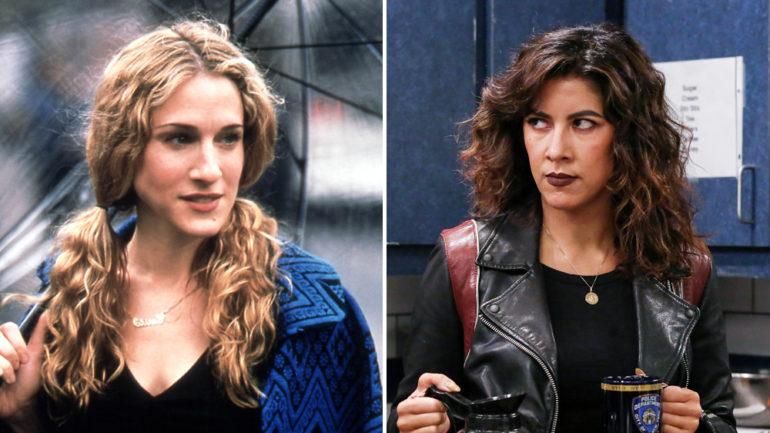How TV Failed Me on Bisexuality — And Then Got Its Act Together (Column)
By Caroline Framke
LOS ANGELES (Variety.com) – Carrie Bradshaw never met a sexual inclination she wouldn’t hear out — until she encountered bisexuality.
“I’m not even sure bisexuality exists,” she complains in a season 3 episode of “,” the HBO comedy named for her supposedly open-minded sex advice column. “I think it’s just a layover on the way to Gaytown.”
Carrie spends the entire episode of “Boy Girl Boy Girl” dating a 26 year-old bisexual man and gritting her teeth about him “choosing” to date both men and women. Besides open-minded sexual explorer Samantha (who shrugs that he’s “evolved”), Carrie’s friends share her disdain with relish. Miranda insists that he’s “greedy” and “double dipping”; Charlotte sniffs that he should “just pick a side and stay there.”
Eventually, Carrie eventually writes off his sexual orientation as a quirk of belonging to a younger generation. As she finally leaves him behind at a party full of his sexually fluid friends and exes, her concluding voiceover shrugs that she’s just “too old to play this game” — as if bisexuality were a condition one could grow out of.
“Boy Girl Boy Girl” wasn’t an aberration when it aired in 2000. In fact, its wholesale dismissal of bisexuality provides a neat summary of exactly what TV tended to say about anyone who dared “double dip.” Bisexual characters (if they were even labeled as such) were often viewed through sneers as promiscuous troublemakers who couldn’t make up their minds. Even “The L Word,” Showtime’s groundbreaking series centering queer women, turned its nose up at bisexuality every chance it got. When I was in college, the most visible bisexual representation on TV belonged to the MTV dating show “A Shot At Love With Tila Tequila,” a booze-soaked nightmare that emphasized every cliche there is. So when Sara Ramirez’s “Grey’s Anatomy” character Callie made history in 2008 by accepting her bisexuality on network television, the nuance of it was so rare that it was genuinely confusing. (“Bones” and “House” soon followed in “Grey’s” footsteps, though neither gave as much onscreen attention to that aspect of their characters.)
It took me a long time to realize why I was so frustrated by TV’s shortsighted approach to any sexuality outside a black and white sexuality binary. It wasn’t until a few years ago that I accepted the fact that I, too, exist in the vast gray area of sexuality that TV rarely deigned to respect.
Granted, maybe the bone-deep disappointment I felt when some character rolled their eyes at bisexuality should have tipped me off. But I also believe that I would have been far more open to the idea of being bisexual if I had witnessed it depicted as an intrinsic part of life rather than an attention-seeking choice or “layover on the way to Gaytown.” Even in real life, I didn’t have to look further than the way media treated Angelina Jolie or Alan Cumming to know how I might be received.
Whenever I let myself think about this too hard, I get very angry about what feels like a real loss. A loss of time, opportunity, and affirming validation I could have used to understand myself better far earlier. But the way I usually calm down is by looking around today, and knowing that if I were a flailing, closeted bisexual TV obsessive in 2019, I would be overwhelmed with so many better options.
A decade after Callie first realized her queerness, TV has progressed on bi and pansexuality beyond my wildest dreams. Network dramas “The 100” (The CW) and “How To Get Away with Murder” (ABC) fleshed out their lead characters by organically revealing their bisexuality. Carrie Bradshaw’s ex got spiritual redemption in “Crazy Ex-Girlfriend” character Darryl Whitefeather, whose joyous “Getting Bi” solo directly slams the pernicious clichés “Sex and the City” clung to. When “Jane the Virgin” standout Petra let herself be vulnerable for the first time in a relationship, it was, for the first time, with a woman.
It’s also no coincidence that some of today’s best storylines about bisexuality come from writers and actors who are bisexual themselves. Ramirez now plays a bisexual political strategist on “Madam Secretary.” “Broad City” star Abbi Jacobson brought her own experiences into the show’s final season, which explored her character’s surprising new attraction to another woman. “Brooklyn Nine-Nine” and “Abby’s” made network comedy history with characters — played by openly bi actors Stephanie Beatriz and Natalie Morales — who explicitly spoke to the nuances of being bisexual. Filmmaker Desiree Ahkavan recently turned her experiences of biphobia into a probing series called, fittingly and bluntly enough, “The Bisexual.”
It’s as encouraging as it is jarring to see this burst of consideration for a sexuality TV considered ridiculous not too long ago. The real test will be seeing how long it lasts — if the industry will treat bisexuality as a trend, something to tap into in order to prove its relevant bonafides. But if we keep up the pressure to get it right, maybe Hollywood and everyone who enjoys it will know what we know, despite the world’s best attempts to convince us otherwise: bisexuality isn’t a phase to grow past. It’s a part of who we are. Reflecting that reality shouldn’t be revolutionary, but a given.

